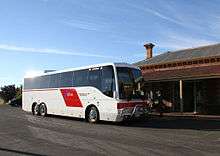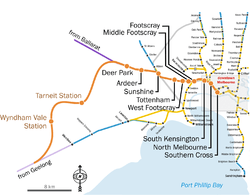Department of Transport (Victoria)
| Department overview | |
|---|---|
| Formed | 2008 |
| Preceding Department |
|
| Dissolved | April 2013 |
| Superseding agency | |
| Jurisdiction | Victorian Government |


The Department of Transport (DOT) was the central government agency responsible for the coordination, integration and regulation of the transport system in the State of Victoria, Australia.[1] The Department generated planning, policy, and legislation for transport in Victoria. As a result, the Department drove the integration of Victoria's transport land and water transport systems and the delivery of public transport, road and port services and associated activities across the State. The Department's stated mission was "Building a safer, fairer and greener transport system for all Victorians to create a more prosperous and connected community."[2]
The Department was replaced in April 2013 by the Department of Transport, Planning and Local Infrastructure.
As of 1 January 2015, the functions of the Department of Transport, Planning and Local Infrastructure have been incorporated into three new departments:
Department of Economic Development, Jobs, Transport and Resources
Department of Environment, Land, Water and Planning
Department of Health and Human Services
Ministerial portfolios
At the time of its abolition, the Department of Transport supported three Ministerial portfolios, the Minister for Public Transport, the Minister for Roads (the Hon Terry Mulder MLA) and the Minister for Ports (the Hon David Hodgett MLA). It also supported one Parliamentary Secretary for Transport (Mr Gary Blackwood MLA).
Governance

The Department of Transport was established in 2008 and assumed the transport portfolio responsibilities of the former Department of Infrastructure. The activities and powers of the Department of Transport were governed by both the portfolios of its Ministers, the Minister for Public Transport, the Minister for Roads, the Minister for Ports and by the Transport Integration Act 2010.[3]
The Department initially started its operation under the Transport Act 1983,[4] which contained an old and minimalist policy framework for the Department and parts of the broader transport portfolio. The development of the Transport Integration Act after a comprehensive process driven by the Transport Legislation Review provided policy and organisational coherence to the Victorian transport portfolio by clarifying the central coordinating role of the Department of Transport. It also provided the Department and its statutory authorities and offices with a clear and modern policy framework and new organisational charters. The charter of the Department was made up of its objects and functions set out in the Transport Integration Act and these commenced in June 2010.
The Secretary of the Department of Transport was Jim Betts who was promoted to the role from the office of Director of Public Transport.
Objects
The objects of the Department are set out in the Transport Integration Act as:
- "(a) ensure that a transport system is provided consistent with the vision statement and the transport system objectives;
- (b) determine strategic policies which specify priorities for the transport system that address current and future challenges;
- (c) ensure in collaboration with transport bodies and other bodies that policies and plans for an integrated and sustainable transport system are developed, aligned and implemented."[5]
Functions
The Transport Integration Act provided that the "...principal function of the Department is to assist the Minister in the administration of this Act and other transport legislation..."[6] Other functions conferred on the Department include[7] -
- being the lead in strategic policy, advice and legislation relating to the transport system and related matters other than road safety
- coordinating the development of regulatory policy and legislation relating to the transport system and related matters
- leading in the improvement of the transport system, including in the procurement, development, construction and commissioning of new transport infrastructure and services
- establishing a medium and long term planning framework for all forms of transport for the delivery of an integrated transport system
- providing independent advice to the Minister in relation to proposals and initiatives of other transport bodies
- developing strategies, plans, standards, performance indicators, programs and projects relating to the transport system
- seeking to ensure, in collaboration with the Public Transport Development Authority, the Roads Corporation and Municipal Councils, that access to road and rail is balanced in a manner consistent with Government policies and strategies for public transport and freight
- coordinating corporate planning and budgets to assist transport bodies with development, alignment, implementation and monitoring of their corporate plans and budgets
- undertaking operational activities including transport system operations, asset management and project management
- collecting transport data and undertake research into the transport system
- providing corporate, financial management, property and other specialist services to transport bodies
- providing assistance to public entities and private bodies to construct or improve transport facilities
- carrying out efficiently and effectively any contract entered into by the Minister on behalf of the Crown
- representing transport interests in liaising with other Victorian, Commonwealth and other jurisdiction's Departments and agencies, including in relation to regulatory reform and funding.
The Act also provided the Secretary of the Department with a range of specific powers including the power to enter into any agreement or contract.[8]
Particular responsibilities
The Transport Integration Act imposed a range of responsibilities on the Department of Transport, including:
- preparation of Victoria's transport plan and revising that plan periodically[9]
- coordination of agencies' corporate plans across the transport portfolios[10]
- taking the lead in policy and legislation review[11] including projects such as the Transport Legislation Review
Transport portfolio agencies
DOT oversaw and coordinated the activities of the state agencies responsible for the transport system in Victoria. These agencies were divided into three main types - statutory offices, statutory authorities and independent transport safety agencies.
Together with DOT, the agencies provided, managed and regulated transport system activities in Victoria including -
- heavy and light rail systems including trains and trams
- roads systems and vehicles including cars, trucks and bicycles
- ports and waterways including commercial ships[12] and recreational vessels
- some air transport systems.[13]
Statutory offices

The statutory offices included -
- the Director of Public Transport
- the Transport Infrastructure Development Agent.
These agencies were part of the Department of Transport but each had a distinct statutory charter and powers.[14]
Statutory authorities

The statutory authorities[15] are -
- the Roads Corporation (VicRoads)
- the Public Transport Victoria (PT)
- Victorian Rail Track (VicTrack)
- V/Line Corporation (V/Line)
- the Taxi Services Commission
- the Linking Melbourne Authority
- the Port of Melbourne Corporation
- the Port of Hastings Development Authority
- the Victorian Regional Channels Authority
- the Transport Ticketing Authority
- the Regional Rail Link Authority.
These agencies were structurally separate from the Department of Transport.[16]
Independent transport safety agencies

The independent transport safety agencies[17] are -
- the Director, Transport Safety (Transport Safety Victoria)
- the Chief Investigator, Transport Safety.
These agencies were part of the Department of Transport but were functionally independent and reported to the relevant Ministers.[18]
See also

- Transport Integration Act
- Rail Safety Act
- Bus Safety Act
- Accident Towing Services Act
- Rail transport in Victoria
- Railways in Melbourne
- Road transport in Victoria
- Trams in Melbourne
- Transport Act 1983
- Transport (Compliance and Miscellaneous) Act 1983
- Tourist and Heritage Railways Act
References

- ↑ Transport Integration Act 2010, sections 32 and 33.
- ↑ Department of Transport, Annual Report 2009-10, page 5.
- ↑ Transport Integration Act 2010, see in particular, Part 3 of the Act.
- ↑ This Act has since been renamed the Transport (Compliance and Miscellaneous) Act 1983.
- ↑ Section 32, Transport Integration Act 2010.
- ↑ Section 33(1), Transport Integration Act 2010.
- ↑ See section 33(2), Transport Integration Act 2010.
- ↑ See sections 34-37, Transport Integration Act 2010.
- ↑ Transport Integration Act 2010, section 63.
- ↑ Transport Integration Act 2010, section 64.
- ↑ Transport Integration Act 2010, section 33(2)(a) and (b).
- ↑ Note, some shipping matters are controlled by the Commonwealth government under legislation such as the Navigation Act 1912. Other matters are within the jurisdiction of states such as Victoria through Acts such as the Transport Integration Act and other statutes such as the Marine Act 1988.
- ↑ Note, many air transport regulation matters are controlled by the Commonwealth Government. The Transport Integration Act would apply, for example, to planning controls at some airports and in respect of transport connections to other airports by road and rail.
- ↑ For information relating to the Director of Public Transport, see Division 1 of Part 5 of the Transport Integration Act 2010. The charter and powers of the Transport Infrastructure Development Agent were set out in Division 4 of Part 3 of the Transport Integration Act 2010.
- ↑ See Parts 5 and 6, Transport Integration Act 2010.
- ↑ The Act established these agencies as structurally separate bodies with their own legal personality. For example, section 81(4) of the Transport Integration Act 2010 established VicRoads as a "body corporate" which "may do and suffer all acts and things that a body corporate may by law do and suffer".
- ↑ Part 7, Transport Integration Act 2010.
- ↑ Section 194, Transport Integration Act 2010.
